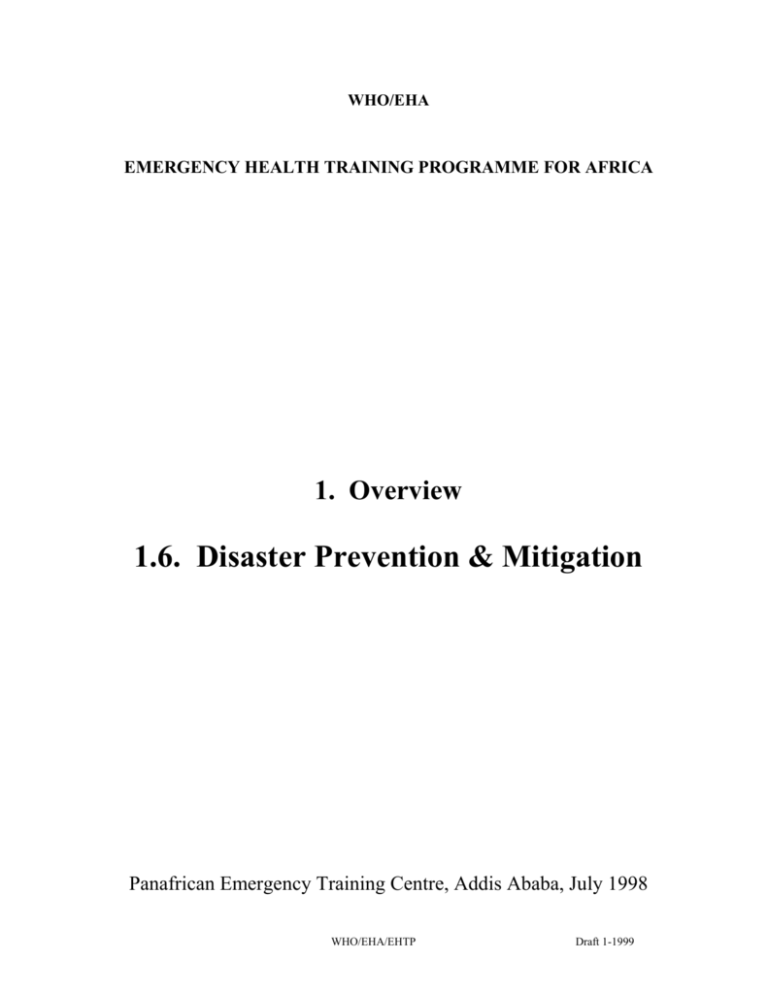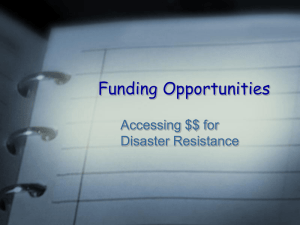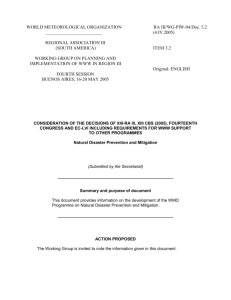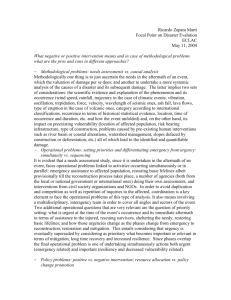mitigation
advertisement

WHO/EHA EMERGENCY HEALTH TRAINING PROGRAMME FOR AFRICA 1. Overview 1.6. Disaster Prevention & Mitigation Panafrican Emergency Training Centre, Addis Ababa, July 1998 WHO/EHA/EHTP Draft 1-1999 1.6. Disaster Prevention - Mitigation Overhead Transparencies 1.6.1. 1.6.2. 1.6.3. 1.6.4. 1.6.5. 1.6.6. 1.6.7. Mitigation, Definition Principal Objectives of Mitigation Menu of Emergency Management Actions Physical Planning Measures Economic Measures Management and Institutional Measures Societal Measures 1.6.8. Engineering and Construction Measures WHO/EHA/EHTP Draft 1-1999 1.6. Disaster Prevention - Mitigation Trainers' Guide Objective: To illustrate different options for disaster prevention and emergency management. (Also applicable to relief and development). (Knowledge) Key-message: Disaster prevention and emergency preparedness are developmental activities: investment in infrastructures and services, governance etc. Range of options, activities, means, tools. 1.6.1. Mitigation, Definition Present and clarify. Mitigation and Prevention are used as synonyms. Some prefer to drop the term Mitigation and use only Prevention. The term Mitigation can be comprised in the term Prevention. Mitigation means to reduce the severity of the human and material damage caused by the disaster. Prevention is to ensure that human action or natural phenomena do not result in disaster or emergency. Primary prevention is to reduce -avert- avoid the risk of the event occurring, by getting rid of the hazard or vulnerability, e.g. to avoid overcrowding, deforestation and to provide services. Healthier people in a healthy environment will be less vulnerable to most hazards. E.g. immunizing people against smallpox made them less vulnerable to the virus, and slowly eradicated the disease. Secondary prevention means to recognise promptly the event and to reduce its effects, e.g. by staying alert to possible displacements of population; by being ready to provide immunisation, food, clean water, sanitation and health care to refugees. Healthier people in a healthy environment will also be more capable to overcome the emergency. 1.6.2. Principal Objectives of Mitigation Discuss. The objective of prevention is to reduce the risk of being affected by a disaster. Even if the hazard cannot be removed, vulnerability can be decreased and in case of an impact, the capacity to withstand, to respond and to recover will be stronger. 1.6.3. Menu of Emergency Management Actions Illustrate. Disaster prevention calls for the co-ordinated effort of the whole society. Disaster Prevention and Emergency Management are multi-sectoral disciplines. WHO/EHA/EHTP Draft 1-1999 1.6.4. Physical Planning Measures Illustrate and ask for examples. Physical measures for urban planners: choosing safe locations for the people’s houses and work. 1.6.5. Economic Measures Illustrate and ask for examples. A diversified economy makes the community less vulnerable: e.g. after a flood all the crops are destroyed, but if the local industry deals with chemicals it will not be affected. Economic incentives and insurance: e.g. loans are granted for safer building; or damage is paid for farmers who suffered from loss of crops and livestock. 1.6.6. Management and Institutional Measures Illustrate and ask for examples. Institutions and structures are needed. 1.6.7. Societal Measures Illustrate and ask for examples. Laws, by-laws and public education are needed. 1.6.8. Engineering and Construction Measures Illustrate and ask for examples. Special infrastructures, special, hazard-proof materials and designs. Engineers must consider two objectives: a) to reduce the effect of the impact of the hazard, e.g. by making buildings stronger; b) to reduce the hazard itself e.g. by building dams to prevent floods. Complementary Essential Reading: African Disaster Handbook, M. S. Zaman, WHO/PTC, 1990 UN-DMTP, Training Modules, UN-DMTP, 1990 EPR Training Handbook for Africa, WHO/PTC, 1992 The Public Health Consequences of Disasters, E. K. Noji, Oxford University Press, 1997 WHO/EHA/EHTP Draft 1-1999 1.6.1. Mitigation, Definition MITIGATION Permanent reduction of the risk of disaster “Primary” Mitigation: reducing the PRESENCE of the Hazard reducing Vulnerability “Secondary” Mitigation: reducing the EFFECTS of the Hazard (Preparedness) WHO/EHA/EHTP Draft 1-1999 1.6.2. Principal Objectives of Mitigation Principal Objectives Of Mitigation Save lives Reduce economic disruption Decrease vulnerability/increase capacity Decrease chance/level of conflict RISK REDUCTION WHO/EHA/EHTP Draft 1-1999 1.6.3. Menu of Emergency Management Actions Engineering Conflict resolution Economic Spatial planning Societal Management and institutionalisation WHO/EHA/EHTP Draft 1-1999 1.6.4. Physical Planning Measures Physical Planning Measures Decentralization of elements at risk Control of population density Design of services and roads Land use regulation WHO/EHA/EHTP Draft 1-1999 1.6.5. Economic Measures Economic Measures Diversification of economic activity Economic incentives (grants loans, taxes) Insurance WHO/EHA/EHTP Draft 1-1999 1.6.6. Management and Institutional Measures Education and training Research Technical expertise Strengthening the capability of local authorities WHO/EHA/EHTP Draft 1-1999 1.6.7. Societal Measures Societal Measures Public information campaigns Education De-sensationalize hazards Community involvement Drills WHO/EHA/EHTP Draft 1-1999 1.6.8. Engineering and Construction Measures Engineering and Construction Measures There are two types: Stronger individual structures Hazard control structures (flood control, levees, dams) WHO/EHA/EHTP Draft 1-1999






